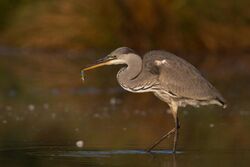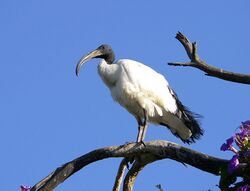Biology:Ardei
| Ardei | |
|---|---|

| |
| Grey heron (Ardea cinerea) | |

| |
| Sacred ibis (Threskiornis aethiopicus) | |
| Scientific classification Error creating thumbnail: Unable to save thumbnail to destination
| |
| Domain: | Eukaryota |
| Kingdom: | Animalia |
| Phylum: | Chordata |
| Class: | Aves |
| Order: | Pelecaniformes |
| Suborder: | Ardei Wagler, 1830 |
| Families | |
| |
Ardei is a suborder of order Pelecaniformes that include the families Ardeidae (herons, egrets, and bitterns) and Threskiornithidae (ibises and spoonbills).[1][2][3] Traditionally the ardeids and threskiornithids were classified in the order Ciconiiformes along with Ciconiidae (storks), Phoenicopteridae (flamingos), Scopidae (hamerkop), Balaenicipitidae (shoebill), and even Cathartidae (New World vultures and condors).[4][5] However, there were some osteological studies that have questioned the monophyly of Ciconiiformes, suggesting that the ardeids and threskiornithids originated from early gruiforms, with the latter being a transitionary taxon to order Charadriiformes.[6] The non-monophyletic nature of Ciconiiformes is supported by recent genomic studies that have found support threskiornithids, ardeids, scopids and balaenicipitids being closely related to Pelecanidae (pelicans).[7][1][2]
The exact relationship between ardeids, threskiornithids and suborder Pelcani is still being investigated with two hypotheses. One hypothesis is ardeids and threskiornithids are each other's sister taxon in suborder Ardei (as presented here).[3] The other hypothesis is the ardeids are the sister taxon to the pelecanid-related clade, with threskiornithids the basal most group. This hypothesis is supported from some morphological and the earliest representations of non-threskiornithid pelecaniforms come from the Oligocene deposits in Africa, while threskiornithids have been found in Eocene deposits of North America and Europe.[8]
References
- ↑ 1.0 1.1 Jarvis, E.D. (2014). "Whole-genome analyses resolve early branches in the tree of life of modern birds". Science 346 (6215): 1320–1331. doi:10.1126/science.1253451. PMID 25504713. Bibcode: 2014Sci...346.1320J.
- ↑ 2.0 2.1 Prum, Richard O.; Berv, Jacob S.; Dornburg, Alex; Field, Daniel J.; Townsend, Jeffrey P.; Lemmon, Emily Moriarty; Lemmon, Alan R. (2015). "A comprehensive phylogeny of birds (Aves) using targeted next-generation DNA sequencing". Nature 526 (7574): 569–573. doi:10.1038/nature15697. ISSN 0028-0836. PMID 26444237. Bibcode: 2015Natur.526..569P.
- ↑ 3.0 3.1 International Ornithological Committee (25 July 2020). "Ibis, spoonbills, herons, hamerkop, shoebill, pelicans". IOC World Bird Names: Version 2.11. WorldBirdNames.org. https://www.worldbirdnames.org/new/bow/pelicans/.
- ↑ Wetmore, A. (1960). "A classification for the birds of the world". Smithsonian Miscellaneous Collections 139 (11): 1–37. https://repository.si.edu/bitstream/handle/10088/22963/SMC_139_Wetmore_1960_11_1-37.pdf?sequence=1&isAllowed=y.
- ↑ Sibley, Charles G., and Ahlquist, Jon E. 1991. Phylogeny and Classification of Birds: A Study in Molecular Evolution. Yale University Press. ISBN:0-300-04085-7. Accessed January 4, 2021.
- ↑ Olson, S.L. (1979). "Multiple origins of the Ciconiiformes.". Proceedings of the Colonial Waterbird Group 2: 165–170. doi:10.2307/1520951. https://www.jstor.org/stable/1520951.
- ↑ Yuri, T (2013). "Parsimony and model-based analyses of indels in avian nuclear genes reveal congruent and incongruent phylogenetic signals". Biology 2 (1): 419–44. doi:10.3390/biology2010419. PMID 24832669.
- ↑ Mayr, G. (2009). Paleogene Fossil Birds. Berlin: Springer Berlin Heidelberg. pp. 1–275. ISBN 978-3540896272.
Wikidata ☰ Q105063209 entry
 |

